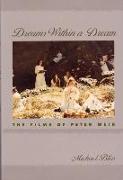Dreams within a Dream
BücherAngebote / Angebote:
What we see and what we seem are but a dream, a dream within a dream", says a character at the beginning of Peter Weir's Picnic at Hanging Rock. The statement is more than just an introduction to Picnic's beautifully ethereal world, it is also a fitting beginning for a consideration of Peter Weir's films. The director of The Year of Living Dangerously, Dead Poets Society, Witness, and the recent The Truman Show is a cinema stylist whose values derive from the realm of the dream and the unconscious. As Michael Bliss demonstrates, for Weir, "empirical reality is nothing more than a shadow of what is real".Bliss considers Weir's heritage, Australian cinema, which gave the director some of his most basic themes: the conflict between reason and mystery, the confrontation with an alien and often threatening landscape, the hero's journey into a region in which good and evil are in cosmic opposition.Bliss also discusses Weir's appropriation and adaptation of another quality endemic to Australian cinema: "mateship", the celebration of the bond between male companions. By making self-knowledge dependent on action involving one's friends, Weir gives mateship a new meaning, as he demonstrates in his celebrated war film Gallipoli.To help explain Weir's films, Bliss looks to Freud and Jung, whom Weir has studied, as well as to two other prominent purveyors of myth and archetype: Northrop Frye and Joseph Campbell. Virtually all of Weir's characters struggle toward a new mode of awareness, one that is based on elemental truths and spiritual unity.Weir's films evidence a striking unity of attitude. From his first widely distributed film, The Cars That Ate Paris, to 1998's The Truman Show, Weir's masterful technique and consistently challenging films mark him as one of our most important contemporary filmmakers. Dreams Within a Dream makes Weir come alive in the emotional and intellectual ways that his films do.
Folgt in ca. 15 Arbeitstagen
